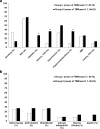[68Ga]Pentixafor-PET/MRI for the detection of Chemokine receptor 4 expression in atherosclerotic plaques
- PMID: 28932900
- PMCID: PMC5829117
- DOI: 10.1007/s00259-017-3831-0
[68Ga]Pentixafor-PET/MRI for the detection of Chemokine receptor 4 expression in atherosclerotic plaques
Abstract
Purpose: The expression of chemokine receptor type 4 (CXCR4) was found co-localized with macrophages on the atherosclerotic vessel wall and participated in the initial emigration of leukocytes. Gallium-68 [68Ga]Pentixafor has recently been introduced for the imaging of atherosclerosis by targeting CXCR4. We sought to evaluate human atherosclerotic lesions using [68Ga]Pentixafor PET/MRI.
Methods: Thirty-eight oncology patients underwent [68Ga]Pentixafor PET/MR imaging at baseline. Maximum standardized uptake values (SUVmax) were derived from hot lesions in seven arterial segments and target-to-blood ratios (TBR) were calculated. ANOVA post-hoc and paired t test were performed for statistical comparison, Spearman's correlation coefficient between uptake ratios and cardiovascular risk factors were assessed. The reproducibility of [68Ga]Pentixafor PET/MRI was assessed in seven patients with a follow-up exanimation by Pearson's regression and Bland-Altman plots analysis.
Results: Thirty-four of 38 patients showed 611 focal [68Ga]Pentixafor uptake that followed the contours of the large arteries. Both prevalence and mean TBRmax were highest in the descending aorta. There were significantly higher TBR values found in men (1.9 ± 0.3) as compared to women (1.7 ± 0.2; p < 0.05). Patients with mean TBRmax > 1.7 showed a significantly higher incidence of diabetes, hypertension hypercholesterolemia and history of cardiovascular disease than patients with mean TBRmax ≤ 1.7. [68Ga]Pentixafor uptake showed a good reproducibility (r = 0.6, p < 0.01), and there was no difference between the mean TBRmax values of plaque lesions (TBRbaseline1.8 ± 0.3 vs TBRfollow-up1.8 ± 0.3) (p = 0.9).
Conclusion: Patients with high arterial uptake showed increased incidence of cardiovascular risk factors, suggesting a potential role of [68Ga]Pentixafor in characterization of atherosclerosis.
Keywords: Atherosclerosis; Chemokine receptor type 4; PET/MRI; [68Ga]Pentixafor.
Conflict of interest statement
Conflict of interest
Hans-Jürgen Wester is shareholder of SCINTOMICS GmbH, Germany. SCINTOMICS owns the IP on Pentixafor.
Ethical approval
The clinical institutional review board approved this study.
Figures





Similar articles
-
[68Ga]Pentixafor PET/MR imaging of chemokine receptor 4 expression in the human carotid artery.Eur J Nucl Med Mol Imaging. 2019 Jul;46(8):1616-1625. doi: 10.1007/s00259-019-04322-7. Epub 2019 Apr 19. Eur J Nucl Med Mol Imaging. 2019. PMID: 31004184 Free PMC article.
-
Clinical Molecular Imaging of Chemokine Receptor CXCR4 Expression in Atherosclerotic Plaque Using 68Ga-Pentixafor PET: Correlation with Cardiovascular Risk Factors and Calcified Plaque Burden.J Nucl Med. 2018 Feb;59(2):266-272. doi: 10.2967/jnumed.117.196485. Epub 2017 Aug 3. J Nucl Med. 2018. PMID: 28775206
-
Imaging the Cytokine Receptor CXCR4 in Atherosclerotic Plaques with the Radiotracer 68Ga-Pentixafor for PET.J Nucl Med. 2017 Mar;58(3):499-506. doi: 10.2967/jnumed.116.179663. Epub 2016 Oct 27. J Nucl Med. 2017. PMID: 27789718
-
Imaging findings and clinical relevance of 68Ga-Pentixafor PET in atherosclerosis: a systematic review.BMC Med Imaging. 2023 Oct 26;23(1):166. doi: 10.1186/s12880-023-01134-y. BMC Med Imaging. 2023. PMID: 37884885 Free PMC article.
-
Advances in PET Imaging of the CXCR4 Receptor: [68Ga]Ga-PentixaFor.Semin Nucl Med. 2024 Jan;54(1):163-170. doi: 10.1053/j.semnuclmed.2023.09.002. Epub 2023 Nov 3. Semin Nucl Med. 2024. PMID: 37923671 Free PMC article. Review.
Cited by
-
CXCR4-Binding Positron Emission Tomography Tracers Link Monocyte Recruitment and Endothelial Injury in Murine Atherosclerosis.Arterioscler Thromb Vasc Biol. 2021 Feb;41(2):822-836. doi: 10.1161/ATVBAHA.120.315053. Epub 2020 Dec 17. Arterioscler Thromb Vasc Biol. 2021. PMID: 33327748 Free PMC article.
-
Novel Positron Emission Tomography Tracers for Imaging Vascular Inflammation.Curr Cardiol Rep. 2020 Aug 9;22(10):119. doi: 10.1007/s11886-020-01372-4. Curr Cardiol Rep. 2020. PMID: 32772188 Free PMC article. Review.
-
PET/MRI of atherosclerosis.Cardiovasc Diagn Ther. 2020 Aug;10(4):1120-1139. doi: 10.21037/cdt.2020.02.09. Cardiovasc Diagn Ther. 2020. PMID: 32968664 Free PMC article. Review.
-
Engineering molecular nanoprobes to target early atherosclerosis: Precise diagnostic tools and promising therapeutic carriers.Nanotheranostics. 2023 Apr 2;7(3):327-344. doi: 10.7150/ntno.82654. eCollection 2023. Nanotheranostics. 2023. PMID: 37064609 Free PMC article. Review.
-
Accuracy of PET quantification in [68Ga]Ga-pentixafor PET/MR imaging of carotid plaques.J Nucl Cardiol. 2022 Apr;29(2):492-502. doi: 10.1007/s12350-020-02257-3. Epub 2020 Jul 21. J Nucl Cardiol. 2022. PMID: 32696137 Free PMC article.
References
MeSH terms
Substances
LinkOut - more resources
Full Text Sources
Other Literature Sources
Medical

